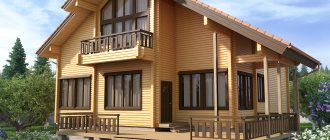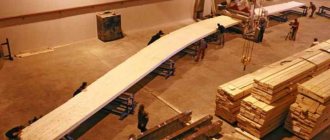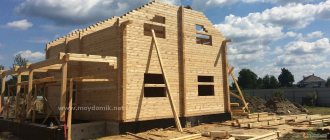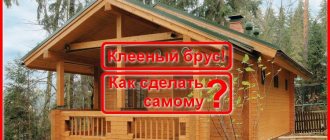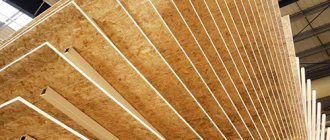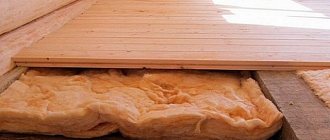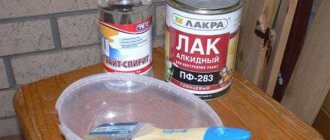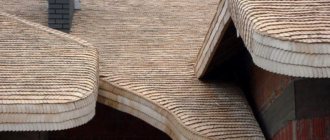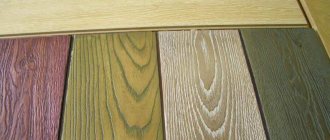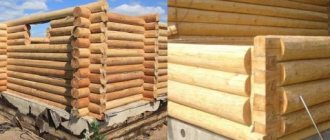When choosing a building material for the implementation of your own home project, you should carefully consider the quality characteristics of the workpieces. This will affect the speed of construction of the structure, the quality of the connection of elements, the thermal performance of the premises and much more. Today, timber comes into view, but not the entire range, but the advantages and disadvantages of laminated veneer lumber. Let's consider the technology for the production of laminated veneer lumber, its features that allow you to make a choice in favor of laminated veneer lumber or other material.
New generation material – laminated veneer lumber
Most people, especially the population of megacities, dream of environmentally friendly housing and better living conditions. Today, traditions going back centuries, coupled with the latest technological processes, make it possible to build wooden houses of excellent quality. Glued laminated timber is the most in demand and popular in the construction of houses, as it is natural, durable and aesthetically pleasing. Such buildings practically do not shrink, have a long service life and are ready for use and finishing immediately after completion of installation work.
Recommendations for choosing products
To purchase the most reliable and safe laminated veneer lumber, you need to take into account the following factors:
- type of gluing of products;
- the number of lamellas, taking into account the thickness of the timber;
- quality of elaboration of the front sides;
- presence and specificity of trimming;
- use of certified adhesive composition;
- reviews about the manufacturer and supplier;
- Possibility of additional ordering if needs change.
These criteria will help you purchase materials with maximum service life. If you strictly adhere to construction technology, you can build a house that will become a cozy home for several generations.
Production Features
The building material we are considering is made this way: logs are radially sawn into boards, which are subsequently well dried (taking into account the type of wood), to approximately 10-12% humidity, and mechanically processed, as a result of which all possible defects are removed. After high-quality drying, the wood undergoes a visual inspection to detect and eliminate areas with dead knots, resin pockets and fungal infections.
Then the boards (otherwise called lamellas) are glued together with special compounds and according to a technology specific to such a material. There can be several of them in the finished timber; the length of the blanks can reach up to 18 meters. Next, the wooden beams are dried, and only after that the laminated veneer lumber is calibrated, that is, it acquires its usual rectangular shape.
Advantages of laminated veneer lumber
Like any building material, laminated veneer lumber has advantages and disadvantages. First, let's look at its advantages:
1. Houses made of laminated veneer lumber are easy to install and assemble, and shrinkage and shrinkage are kept to a minimum.
2. The material practically does not deform and does not change its shape.
3. During operation, it does not become cracked. Its surface is flat and smooth, requiring no additional processing or labor-intensive and expensive finishing work.
4. Glued laminated timber has optimal humidity, which prevents rotting and the appearance of fungal microorganisms and harmful bacteria in it.
5. This material can be used to implement very complex projects.
Nothing is eternal under the Moon
Rain, snow and frost have the same effect on both concrete and profiled timber. The pros and cons of the consequences of these natural phenomena become clear only during the operation of the home. The house will be warm without taking additional measures if it is located in the southern regions of the country. Where frosts reach too low temperatures, profiled (dry) timber must be insulated on the outside of the house. This can be done by additional wall cladding with mineral wool and clapboard or siding.
We advise you to study - Which ceiling is better to make in the bathroom - tips for choosing a finishing option
Wood is an organic material and is susceptible to burning and rotting. Fire retardant impregnations can only temporarily protect against fire from an open fire. To protect it from fungi and mold, profiled timber (photo) must be regularly treated with antiseptics, which sometimes complicates living conditions.
Minuses
However, it cannot be said that laminated veneer lumber is distinguished by positive characteristics alone. There are also disadvantages, here are some of them:
1. High price for glued material. Such a house will cost 2 times more than buildings made from non-profiled logs.
2. Due to the fact that the manufacturing technology is quite new, data on the behavior of this material over long periods of time (for example, after 30-50 years) are not yet available, since its properties have not yet been studied.
3. Use of glue in the production process. Despite the fact that the adhesive compositions comply with the standards, in terms of environmental friendliness, laminated veneer lumber will be inferior to ordinary profiled timber or logs, since they completely lack such substances. The use of glue worsens some characteristics; in any case, air exchange and moisture circulation do not occur fully. In addition, the indoor microclimate is also disrupted.
Construction technology
After drawing up a house project and designating the load-bearing and non-load-bearing walls in it, you can proceed to the first stage of construction - the construction of the foundation. The most reliable type of foundation will be a strip foundation. Unlike other types, it provides reliable support to the house. The optimal foundation depth is 50-70 cm.
Next, you can begin constructing the log house itself. It should be remembered that the log house is erected in rows. You cannot lay out one wall first and then all the others. The house will be built evenly. All seams must be caulked and sealed. And treat the walls themselves with fireproof impregnation.
After the construction of the log house, the roof is built, and then the floor. Upon completion of this stage, they begin the construction of interior partitions and laying communications.
What is the reason for the high price of building materials?
Despite the fact that the desire to live in a house made of natural materials is very great, many are deterred by their cost. Indeed, laminated veneer lumber, the disadvantages of which were discussed a little higher, is more expensive than all conventional analogues made of wood - rounded logs, ordinary timber, etc.
The high cost of such material is undoubtedly influenced by the rather complex process of its production. Production costs, cycles, consumption of wood and resources increase, which cannot but affect the cost.
High-quality laminated veneer lumber, of course, has shortcomings, and all of them lie where there is unfair production, irresponsibility, inattention, negligence when choosing equipment and raw materials, etc. Some people use not very high-quality materials in their work, thereby trying to save money and simplify the manufacturing process. However, the homeowner will soon regret this, as his house will literally begin to fall apart and collapse. On the other hand, real laminated veneer lumber is practically not subject to deformation; it is more durable compared to other lumber. It turns out that the inflated price is completely justified. But the low cost, on the contrary, should alert you.
Video description
Learn more about the production technology of laminated veneer lumber in the following video:
Wood selection
For the production of material, coniferous trees are considered optimal, including:
- Pine . The most affordable material (due to the rapid growth of trees) and therefore popular material. The best wood is pine, which is brought from the northern forests - Arkhangelsk, Karelian, Angarsk.
- Spruce . It has ideal wood for construction; used both for load-bearing walls and for partitions, floors and doors. Disadvantages that relegate spruce to second place are increased knotiness and resin content of the wood; In addition, spruce is inferior to pine in terms of growth and behaves capriciously when drying (it can warp).
Glued laminated timber from larch Source extraslots.ru
See also: Catalog of projects of houses made of laminated veneer lumber presented at the exhibition “Low-Rise Country”.
- Larch . The wood is second only to oak in hardness, resists rotting, and thanks to a special resin with antiseptic properties, it is protected from infection by mold, mildew and wood-boring beetles. Thanks to these properties, larch timber is a valuable building material.
- Cedar . Wood, saturated with essential oils, has been valued since ancient times (mentioned in the Bible) and is similar in properties to larch wood, only less dense. Cedar wood is valued for its beauty and is in high demand, although it is not cheap.
- Oak _ Although it is not a coniferous tree, it has a beautiful texture, strength and resistance to rotting. Over time, the wood acquires a noble shade and, as a rule, is used for the manufacture of external lamellas of timber.
Is laminated veneer lumber safe?
There are often disagreements about the safety of materials such as laminated veneer lumber for humans and the environment. The reason for this controversy is the use of glue in the manufacturing process.
Here you need to take into account that the substances used in the manufacture of such timber consist of natural-based materials. In some ways, glue can be compared to wood resin, which is more durable and resistant to various influences. But since laminated veneer lumber, the advantages and disadvantages of which we have already examined, consists of several boards glued together, there is no need to talk about good movement of moisture and air. Accordingly, we can draw the following conclusion: it is not as useful as solid wood, but it cannot be called harmful either, since all materials used for its production are necessarily certified.
According to statistics, many ordinary homeowners and construction companies choose laminated veneer lumber. Disadvantages (reviews about the use of this material confirm this), of course, affect some properties of wood, but this is not critical.
Video description
About the advantages of laminated veneer lumber in the following video:
Northern forest harvesting Source rubankom.com
Correct Techniques
- Sawing . It not only sets the shape of the lamellas (thickness and length). Proper cutting eliminates wood tension, which is caused by different humidity and density of material layers (both external and internal, in annual rings). When drying, the wood will not deform.
- Gluing . With a properly organized process, the lamella from the core part (with a denser structure) is located on the outside of the beam, reducing the likelihood of cracking. Parts of the timber are glued together with alternating fiber directions, which gives special strength to the product.
- Milling . High-precision equipment allows you to obtain locking connections with precise geometric parameters. Such locks connect structural elements, eliminating the appearance of cracks.
The unusual design was made possible thanks to bent timber Source sledcomspb.ru
See also: Catalog of companies that specialize in the construction of turnkey laminated timber country houses.
Materials: types and classification
Manufacturers produce various types of laminated veneer lumber, which can be sorted according to several criteria:
- Appearance . The market offers a regular and profiled version of the product. Profiled parts can have locks, grooves or ridges, making installation quick and neat.
- Dimensions . The timber is produced in standard sizes and profiles, within which you can order products of any dimensions (length).
- Bonding technologies . There are horizontal beams (two boards are glued together in a horizontal plane), vertical (a harder board forms the outer surface) and salon (includes 4 to 8 layers). The material is often combined: larch or cedar is used for the front slats, pine or spruce is used for the internal slats.
Beams of non-standard sizes for the implementation of design projects Source cafe-ayo.ru
Varieties
There are different types of this material. Depending on the design and purpose, they can be divided into 2 groups:
1. Building materials for the construction of walls (for this, insulated or ordinary laminated veneer lumber is used).
2. Materials for the construction of individual structures (bent laminated veneer lumber and window beams, floor beams, etc.). The most popular are the Finnish and German types. Scandinavian laminated veneer lumber, the only disadvantage of which is that it requires the use of additional compaction (and in general it is a common type of profile), differs from the rest in the presence of two side tenons and special grooves. Such products are connected with a strong lock, and in the middle there is a place for laying the seal. The German profile is recognized by its comb-shaped connection. It provides maximum density without the use of sealing material.
Difference from usual
If we draw an analogy between these two materials, then there is not much difference between them. The first is the profile shape. In ordinary material it takes the form of a rectangle or square, in glued material it takes the form of a complex geometry. In addition, minor elements play an important role in determining the properties of these lumber.
You can find out which is better than logs or laminated veneer lumber from the article here.
The next difference is the cost. There is a big difference in price between regular and laminated timber. For example, the average cost of ordinary timber per m3 will be 7,000-9,000 rubles, but laminated timber – 18,000-24,000 rubles. Which option is right for you is up to you to decide.
In this article you can learn how to make a wooden floor in a house.
The video shows the advantages of laminated veneer lumber over regular timber:

